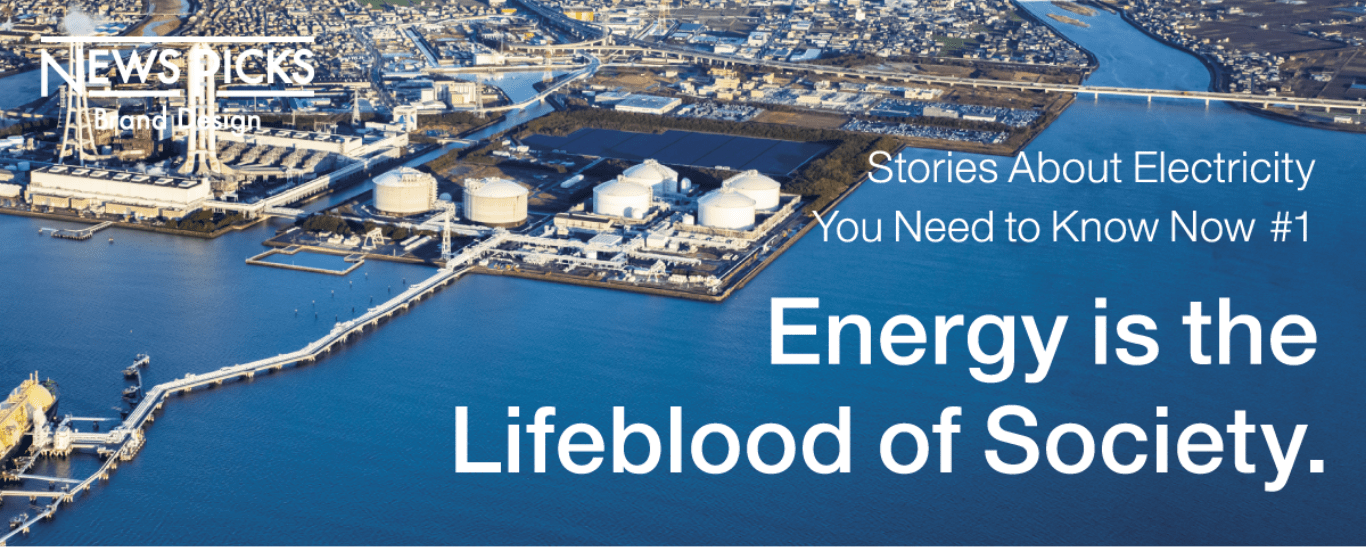
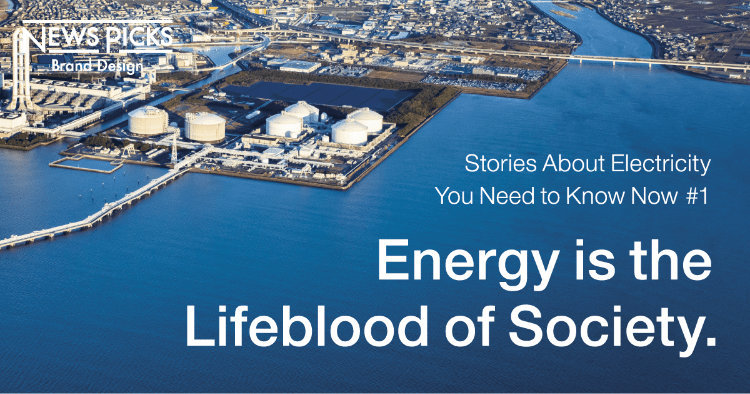
【The Anatomy of JERA】
The 4.4 Trillion-Yen Company Driving the Energy Transition in Resource-Poor Japan
23 March 2023
An energy shift toward decarbonization, fuel prices that rise and fall with the international situation, a global scramble for resources—such uncertainties force Japan to navigate a difficult route to a stable supply of electricity. The key is thermal power, which accounts for nearly 80% of Japan’s energy mix.
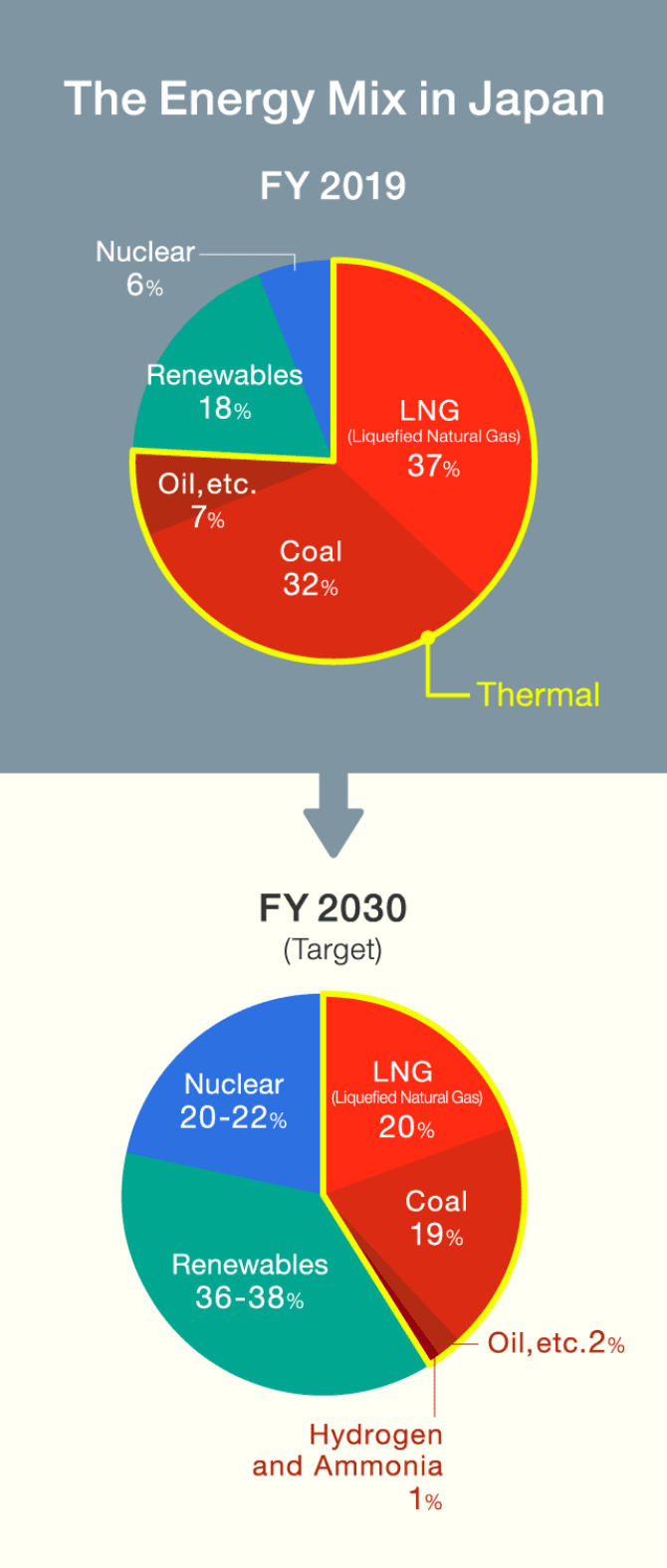
Source: The 6th Strategic Energy Plan, Agency for Natural Resources and Energy (October 2021)
Even under the “ambitious outlook” that the Japanese government indicated in its 2021 Strategic Energy Plan, the ratio of renewable energy in 2030 is under 40%. Even building in 20% nuclear power, the plan covers the more than 40% that remains with thermal power. If the thermal power plants currently in operation were to be phased out one after another simply because they had aged, it would be difficult to secure a stable supply of electricity in the event that renewable energy and nuclear power generation do not increase sufficiently.
INDEX
How to Be Competitive in a Global Market?
How can we reduce carbon emissions and develop the economy while maintaining a stable supply of electricity? For that matter, how can we secure sufficient sources of power as electricity market liberalization draws in many new entrants? JERA is a key player in tackling this vexing problem. Founded in 2015, JERA is the world’s largest electricity producer, handling the entire value chain from upstream fuel development to transportation and power generation.

Satoshi Onoda, President of JERA, says that achieving both decarbonization and a stable supply of electricity in resource-poor Japan “requires not only combining renewable energy with low-carbon thermal power but also optimization across the entire global value chain.” In the interview below, Onoda shares his vision for the transition that JERA is undertaking.
An Energy Supply Base for the Future
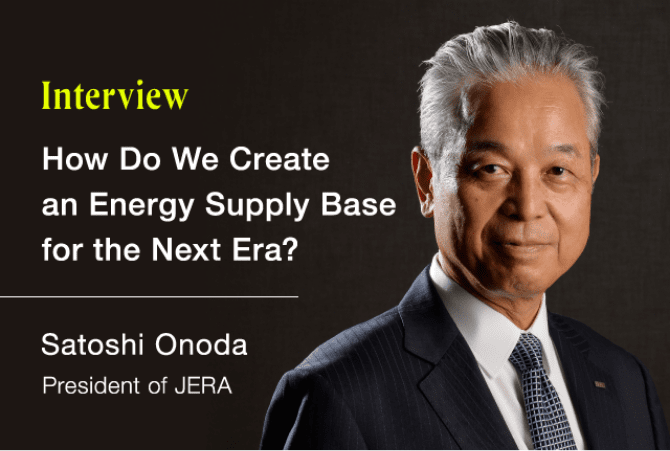
──JERA defines its mission as “to provide cutting-edge solutions to the world’s energy issues.”
Onoda—Right. That’s our starting point. Beyond that, our vision is to provide a supply base for clean energy that combines renewable energy with low-carbon thermal power and to contribute to healthy growth and development in the world and especially Asia. Three aims underly this vision: stability of supply, reducing carbon emissions, and growing as a global company.
Energy is like the lifeblood of manufacturing and our everyday lives—an indispensable resource that makes society and industry possible. How will it be procured and used? It is imperative that we look at the entire value chain, from production to consumption, as we move forward with achievable optimizations.
— In 2020, even before the national government’s declaration about carbon neutrality, JERA announced its JERA Zero CO₂ Emissions 2050 objective and drew a road map for achieving net-zero CO₂ emissions in its domestic and overseas operations.
That’s right. JERA isn’t just about creating new businesses. Having inherited the DNA of our electric utility parents, we are also responsible for social infrastructure. We must first provide firm support for a stable supply of electricity to meet our immediate needs. There is criticism of electricity generation that uses fossil fuels such as coal and LNG, but for the time being we cannot keep up with electricity demand without using thermal power. Replacing old power plants with more efficient equipment that uses less fuel also enables us to reduce CO₂ emissions correspondingly. We can then reduce carbon emissions even further by replacing coal and LNG with non-fossil fuels such as ammonia and hydrogen.
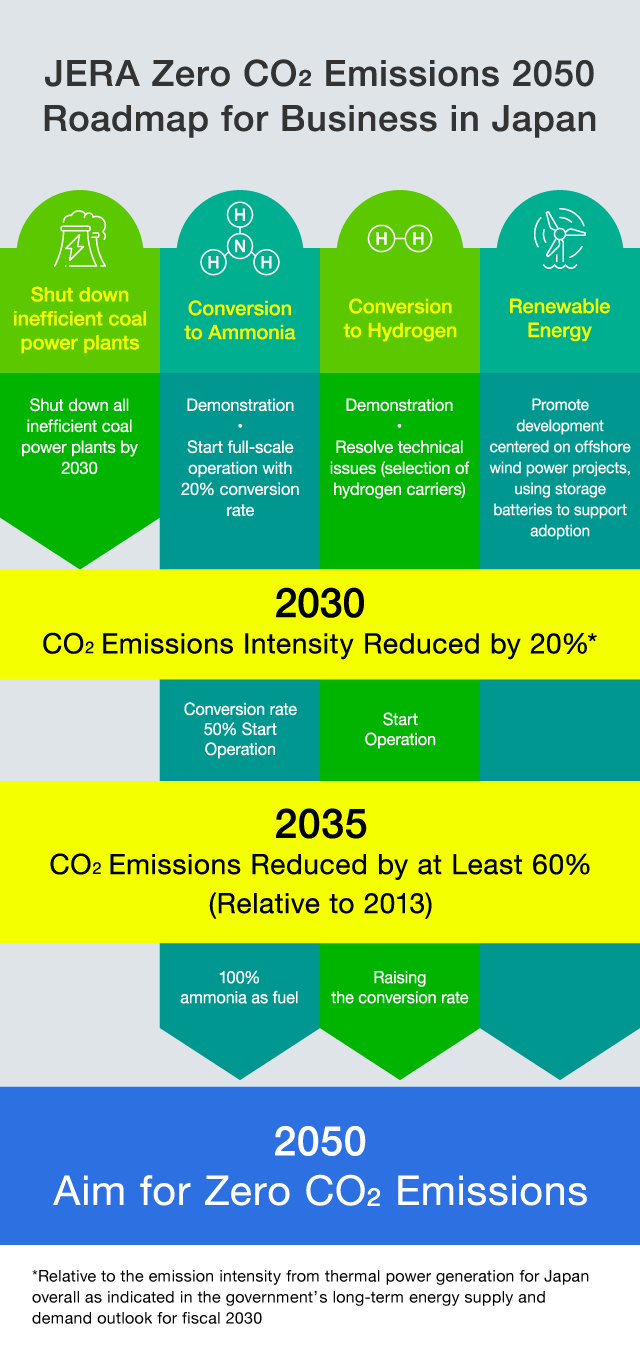
JERA, Japan’s largest thermal power producer, is working on technology to convert LNG thermal power to CO2 emission-free H2 (hydrogen) and coal thermal power to NH3 (ammonia) . The higher the hydrogen or ammonia conversion rate, the lower the CO2 emissions.
From FY 2022 to FY 2024, we will begin operating a series of state-of-the-art thermal power plants with a total capacity of about 6.66 million kW. Generators can only play a leading role for about thirty years, so the next cycle will begin right around 2050. Between now and then, our mission at JERA is to develop as many energy options as we realistically can in light of Japan’s geography.
One way to do this is converting ammonia at coal-fired power plants. We are moving forward with demonstrations and technology development, and aim to achieve a coal-fired power plant with 100% ammonia emissions—in other words, a CO2 emission-free thermal power plant—by 2050.
Ambitious Targets and Realistic Solutions for the Transition
— Europe is pushing for renewable energy and hydrogen, so why ammonia?
One reason is that the optimal conditions for these energy shifts differ by country and region. Given the cost of renewable power generation in Europe, where strong westerly winds blow year-round, and the ability to transport gas using existing pipelines, their choice may be reasonable.
As an island nation, though, Japan has to transport fuel using tankers. Considering transportation costs, our optimal solution will be different, in the same way that we use natural gas in the form of liquefied natural gas (LNG) because it is easier to transport.
— How are hydrogen and ammonia used differently?
To liquefy hydrogen like LNG, it needs to be cooled to -253 degrees Celsius. Transportation costs are also expected to increase, so a major challenge is that hydrogen does not currently make it possible to lower the cost of power generation.
Combining hydrogen and nitrogen, though, creates ammonia, which is easy to liquefy and suitable for storage and transportation. Initially, therefore, ammonia was considered as a possible means of transporting hydrogen more efficiently.
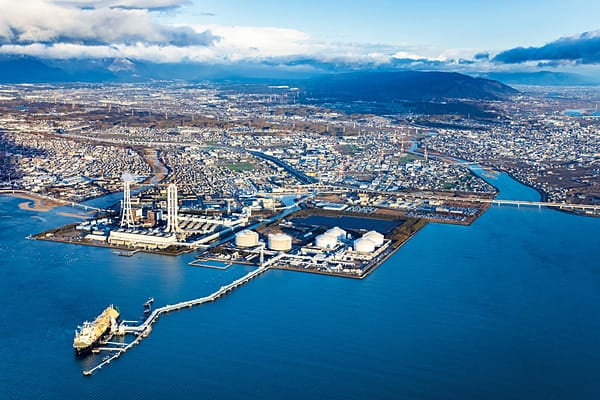
Located in a port area that facilitates LNG transport, this thermal power plant is equipped with receiving piers, storage tanks, and LNG vaporization facilities. (Photo: JERA, Kawagoe Thermal Power Plant in Mie Prefecture).
However, even if hydrogen were converted into ammonia and brought to Japan, we would still have to use energy to convert it back to hydrogen, incurring additional costs. The idea of creating a thermal power plant that used ammonia as a fuel was inspired by a change in thinking: “Why don’t we just burn the ammonia as it is?”
Burning ammonia produces NOx (nitrogen oxides) that can cause photochemical smog, but thermal power plants in Japan are already equipped with denitrification equipment to process NOx. We found that by utilizing such equipment it was possible to burn a mix of ammonia and coal with just a few modifications to the thermal power plant burners.
— I see. So, it’s also important to be able to repurpose existing equipment?
It’s very important. We call it making a “smart transition,” but the bottom line is to start by doing what we can with the technology we have. Conversion to ammonia is suitable for coal-fired power generation at low combustion temperatures. At the same time, current state-of-the-art LNG-fired power generation has combustion temperatures as high as 1,500–1,600 degrees Celsius. In that case, hydrogen is more suitable because burning ammonia generates too much NOx.
Many coal-fired power plants have just been built, especially in Southeast Asia. We believe that converting ammonia, which can be achieved with a few modifications, is an effective solution to reduce CO2 emissions from these plants.
Europe also initially set extremely ambitious decarbonization goals and took a sharp turn in shifting to renewable energy and hydrogen. In the summer of 2021, however, the lack of westerly winds reduced the amount of electricity generated from offshore wind farms. LNG was needed to make up the shortfall, causing natural gas stocks to dwindle rapidly. In addition, the Russian invasion of Ukraine in February of this year started a global scramble for fuel. My sense is that as countries are forced to restructure their power and energy supply networks, they are starting to look not only at LNG but also at ammonia, which has not received much attention until now.
The DNA to Create a New Era
— What challenges do you see now in creating a new electricity supply base?
There are many challenges in terms of technology development and of strengthening global procurement and other aspects of the value chain. JERA is proud to be responsible for the social infrastructure of electric power. It’s where we come from and something we must never stop. At the same time, we can hardly shelve decarbonization just because it creates difficulties in providing a stable supply of electricity to meet our immediate needs.
In order to create a supply base for clean energy that combines low-carbon thermal power and renewable energy, we not only have to work on reducing carbon emissions from thermal power generation, but also to invest in and increase renewable energy sources such as offshore wind. JERA has been working on offshore wind power projects in Taiwan and the United Kingdom, but one of our strengths that other developers lack is the know-how to operate and manage facilities over the course of decades without reducing their generation efficiency.
— What exactly is that know-how?
For example, a thermal power plant is a collection of various machines such as motors, pumps, and turbines. Different parts have different life spans, and a variety of parameters like heat, sound, and vibration are used to predict when they will fail. A veteran engineer might hold a stethoscope to his ear, detect by sound when a motor bearing is about to crack, and perform maintenance before it fails. When something goes wrong, engineers not only have to fix it but also to judge whether doing so requires shutting down the generator or not, and whether to repair or replace altogether. We’ve taken care of things the right way each time, taking into account the life cycle of the entire machine.
Japan is so good at this kind of know-how that, compared to overseas power generation facilities, we can maintain efficiency to the end. Today we are especially focused on predictive management technologies that enable sensors and AI to do at least as much as veteran engineers. Thermal power generation uses steam or gas to turn turbines. Wind power generation equipment, although it has fewer parts, relies on similar rotating bodies so we can apply the various control technologies and expertise that we have cultivated in thermal power.
— So you’ll be offering solutions, including those technologies, to the world?
That’s right. Ammonia-fired solutions, maintenance technologies, and upstream development and transportation value chains—JERA will utilize its assets to address global energy issues.
Working with electricity and energy infrastructure requires a commitment not only to business but also to society. It’s not just a matter of building and selling equipment somewhere or generating electricity to produce revenue. We support infrastructure that’s closely aligned with life in a country and enriches the area’s industry and livelihood. This kind of harmonization, and bolstering of the global value chain, ultimately leads to a more stable supply of electricity in Japan. I’m convinced of it.
Produced by NewsPicks Brand Design
Edited by Koji Uno
Designed by Kumi Kotani
Photographed by Kazushige Mori
This article is based on a Japanese article produced by NewsPicks Brand Design, which sponsored and translated by JERA.
https://newspicks.com/news/7843165
※ May 10, 2024, some wording was changed.
RELATED STORIES

【A Japan First】CO2 Emissions Free Thermal Power Generation Captures the Interest of the World
Japan’s largest coal-fired power station, Hekinan Thermal Power Station, is located about 40 kilometers south and …
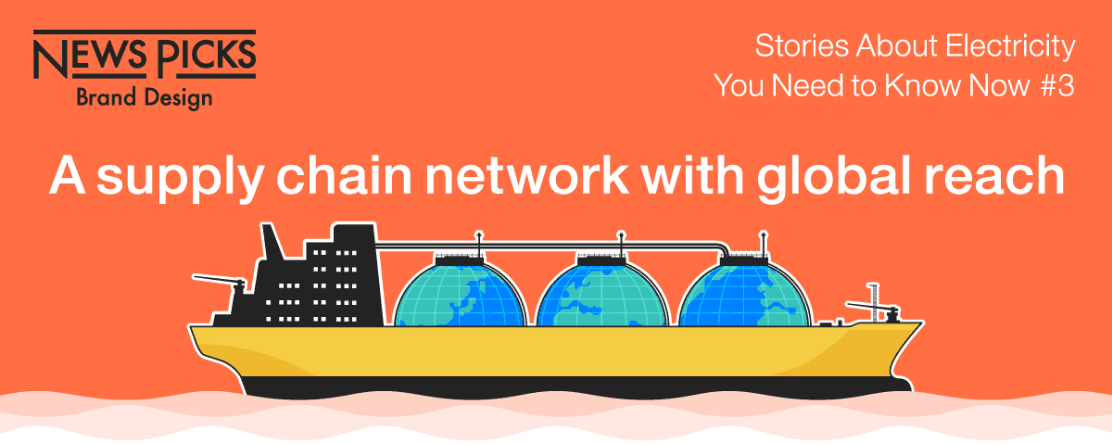
A new era for energy. Where does electricity come from?
“I wanted to build a globally competitive company.”These are the words of Yukio Kani, one of the key people behind…

